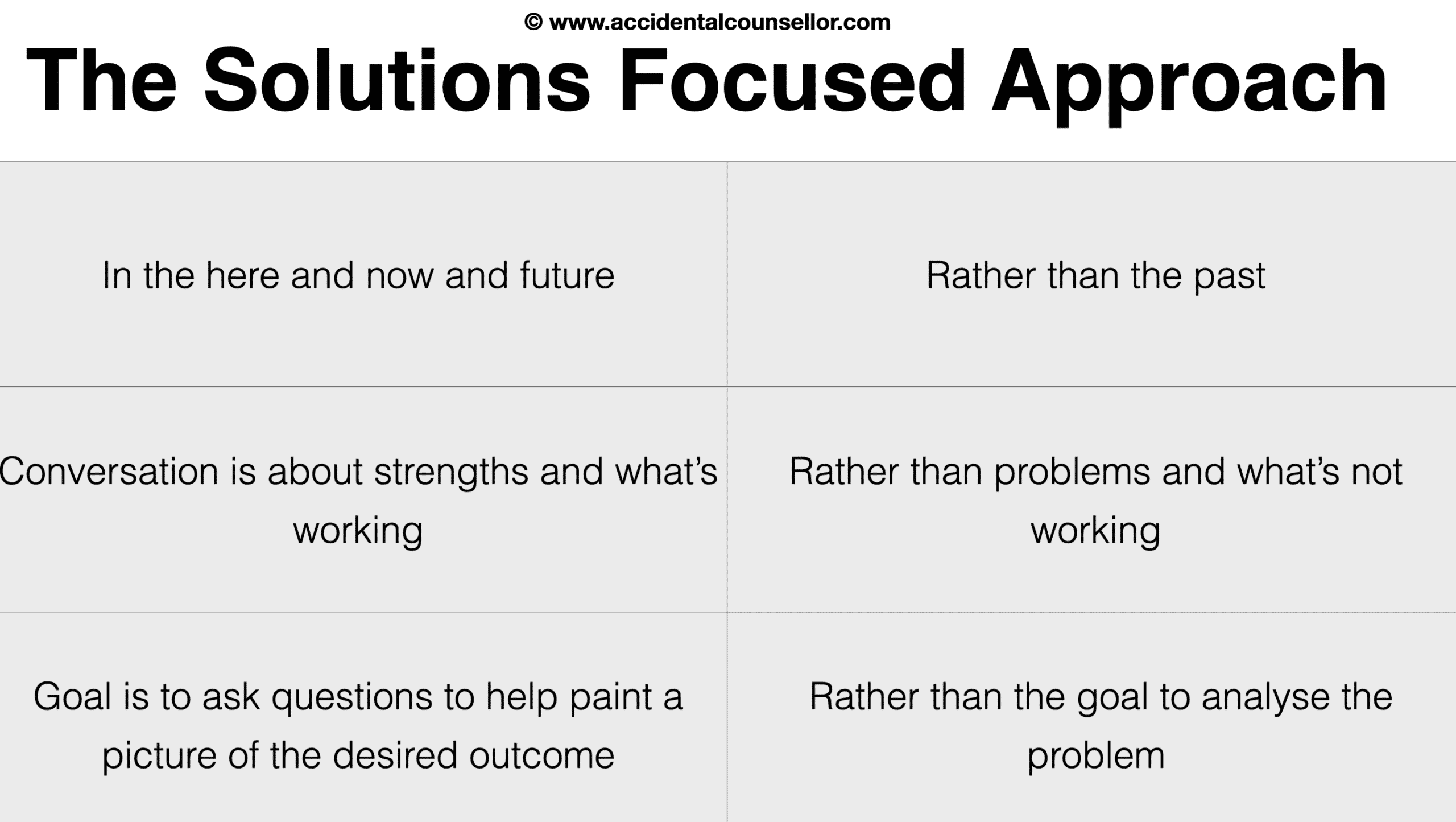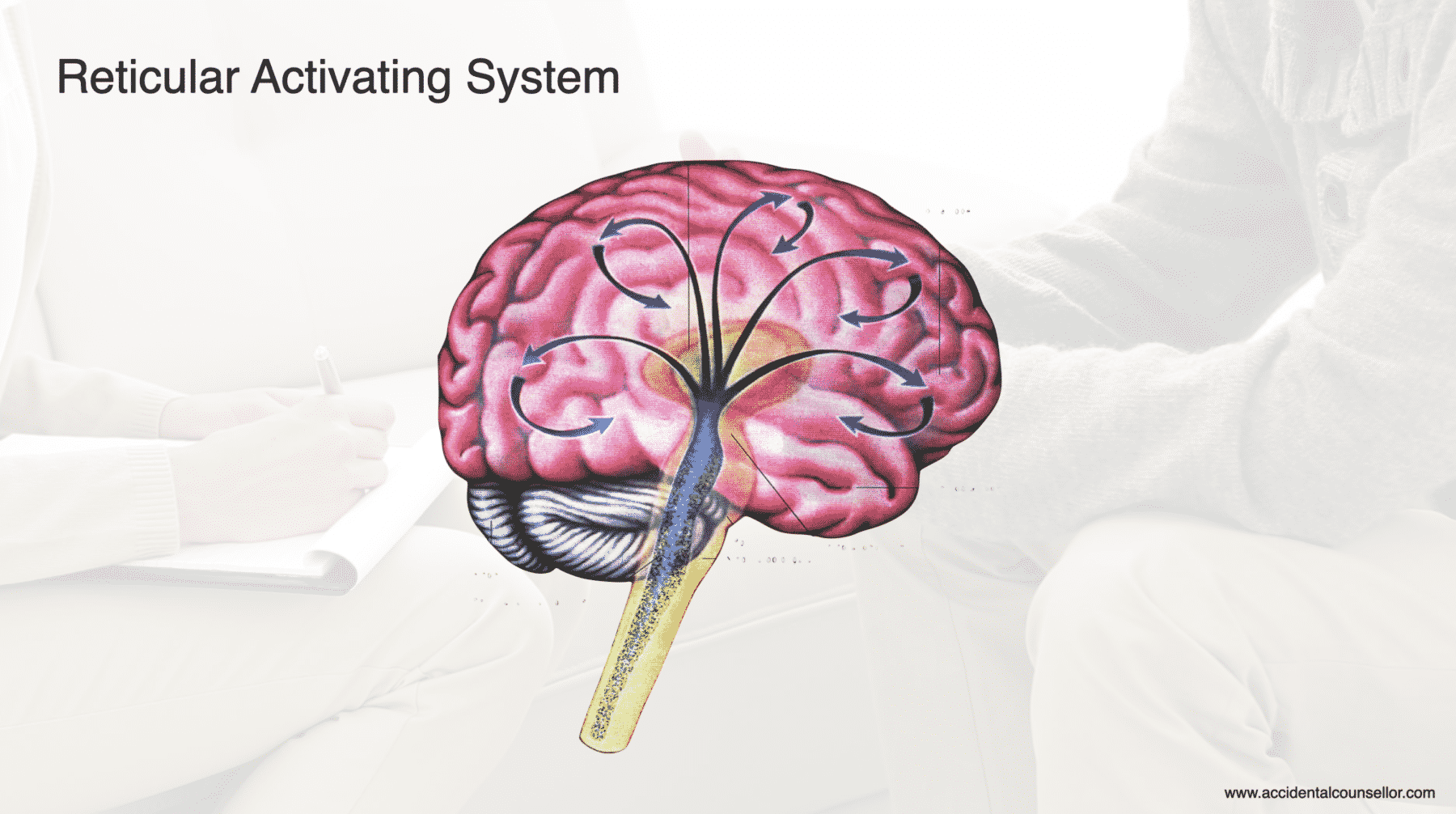The Accidental Counsellor training that I’ve created is based on the Solution-Focused Approach to counselling and communication. Let’s start with the following solution-focused questions:
- What are you hoping to learnmost from this short course?
- Once you answer that question,reflect on the reason it’s important for you to learn that now?
- If you could learn that and put it into action,how would that benefit you and others?
Take a moment to reflect on your answers to these questions.
If you pay attention to your responses, you’ll see that there’s a common theme and pattern. The questions help you to paint a picture of how you would like things to be.
The primary goal of solution-focused questions is to help someone paint a picture of how they’d like things to be; I like to frame it as a picture of their next best step. This is really important because when we follow this process, we activate a part of the brain called the Reticular Activating System.
I like to describe what this part of the brain does is a little bit like this…
Have you ever purchased a car, but perhaps at the start of the process, you weren’t quite sure what type of car, colour, make or model you wanted? You did some research, spoke to some people and, after a period of time, you have a very clear image in your mind of the car – the colour, the make, the model – that you want. Once you know what type of car you want, you are able to purchase it.
You pick up this car and start driving around. What do you notice about the other cars? What do they look like? If you’ve responded that they look similar, that’s a typical response because most people start noticing their car all over the place. And this is true for most things.
My wife and I couldn’t have kids for 15 years. Now, we only have one. I don’t know what you think about miracles, but she’s a miracle to us. As you can easily imagine, when Anna was pregnant, we just started seeing pregnant women everywhere. Right? I think you get the idea, and you’ve probably had similar types of experiences yourself.
When we picked up our Labrador puppy, we started noticing these Labrador puppies all over our suburb.
They were always there. The cars were also always there, but because you’re focused on it, you see it much, much more. Oftentimes, when people do the Accidental Counsellor Training with me, one of the key worries that people have is that they may say the wrong thing. I want to help allay those fears.
What If I Say The Wrong Thing?
I think we need to be much more mindful of the connection that we have with the person to whom we are communicating. Because, if we’ve got a really good connection, where the person feels heard, we don’t have to get everything right. In that case, if you say something that’s not quite right, it’s easily forgiven. However, if the connection’s not good, then poor communication may be much more triggering.
People worry that they’re going to make situations worse by saying the wrong thing. But, I don’t think that’s how it works, as long as we’ve got the right intention and connection in the work that we do when we’re trying to help the person. Instead of worrying about saying the wrong thing, I would suggest being much more mindful of the questions you ask, because, when you ask someone a question their focus and direction are instantly pulled toward that question.
I’m going to ask you a random question, and I want you to engage with it and see what happens in your mind. What are the colours of the walls in your bedroom? Did you get that? What are the colours of the walls in your bedroom? Now, if you thought about that question, even for a moment, your mind recollected and pictured the colour of the walls in your bedroom. Completely random question. That’s how powerful a question is. It opens up a loop in your brain, and the brain naturally goes there. Thus, it is important to consider where you want a person’s focus to go when you ask a question? Where their focus goes, energy flows. Think about the outcome. Where do you want to get to in this conversation? Then, frame your questions around that desired end point and work backward from there.
Setting The Agenda Questions
Here’s an example from a transcript with a client who I saw a couple of years ago.
If you look at this first question here, “How are you hoping our chat can be of help to you today?”, you’ll notice that this is a very similar question to the one I asked you at the start of this short course, which was, what are you hoping to get from the session?
Her response was, “Well, I’m hoping you can help me with my anxiety.”
To which I replied, “If talking to me now turns out to make things better for you, what would be different?”
And she said, “I’ll be less anxious and more calm and happier.”
Then, I said, “Great, what would you typically be doing differently if you were calm and happier?”
And she said, “I’d be going out more and spending more time with my family and friends.”
I continued for nearly 15 minutes by asking her a series of questions: “Tell me more. Where would you be going out? Who would you be going out with?” – so on and so forth. Now, I want to break down this little transcript, because there are three key things I want to share with you.
First of all, let’s have a look at the very bottom thing here. When she said that she’d be going out more and spending more time with family and friends, if I had responded by simply saying “That’s nice” and just leaving it there, that would not have painted a concrete, specific and detailed enough picture in her mind to activate that part of the brain we just spoke about, the Reticular Activating System.
When she said, “I’d be spending more time with my family and friends,” I asked, “Which one more do you think, family or friends?”
“Friends,” she said.
“Where would you be going out?”
“Our local cafe.”
“What is it about the cafe?”
“Oh, the food, the coffee.”
“And if you were there with your friends and you were having a conversation, what sort of things would you guys be talking about?”
3 Key Points
It looks really odd, and you might have wondered what this has to do with anxiety? But now you know why we do this, right? The whole idea of the solution-focused approach is to ask questions so that the person paints a picture of their next best step. When they start doing that, you want to start asking questions so that they start painting a detailed, concrete and specific picture. That’s the first point that I want to talk to you about here.
Another thing that I think is really important to point out is where she says, “I’d be less anxious and more calm and happier.” This is really important, because when you start asking these types of solution-focused questions, you need to be aware that 80 to 90% of people will respond with the absence of something. “I’d be less anxious” is the absence of something.
They begin by responding to the absence of something, rather than the presence of something. “More calm and happier” is the presence of something. Let’s imagine for a moment that she didn’t say “more calm and happier”, because that’s what happens most times. Let’s imagine that she just said “be less anxious, or I wouldn’t be so stressed. I wouldn’t be so worried”. The problem with this description is that stressed, anxious and worried are the ideas that are remaining in the brain. We don’t want that, right?
As I explained about the Reticular Activating System, we’re searching for what the person wants – what would actually be there if things are better. Thus, we need to be able to help them with some questions, to be able to pull them out of the absence of something and into the presence of something.
I have a video here that provides a very short demonstration of this.
This woman was at a workshop. When we run our public workshops, we have people from all sectors.
She was working with people who had drug and alcohol issues, and she was role-playing a person called Peter. The issue with Peter was that when he got depressed, he dosed up, and he needed to work on that and get clean so that he could have access to his children.
I said, “How would you cope with feeling down?
Then he said, “I wouldn’t dose up.”
This is a classic example of asking a solution-focused question and the person giving a response based on the absence of something, “I wouldn’t dose up”.
Have a look at the question I asked – I asked it twice – and how it pulls the person out of “I wouldn’t dose up” to actually consider the presence rather than the absence of something:
Rocky: So, Peter, you just told me that you’ve got to be aware, so then you don’t dose up, right? What would you be doing when you were feeling down and you weren’t dosing up? What would you be doing instead?
Peter: Just on a regular day?
Rocky: You’re feeling down?
Peter: Yeah.
Rocky: This is the risk, isn’t it? That’s the risk factor.
Peter: Yeah.
Rocky: Okay, so you’re feeling down, and you said to me, “I’m not gonna dose up.” And I’m going, “Okay. So, what would you do instead? How would you cope with this down?”
Peter: Sometimes I just go out to the shops, just try to distract myself, but then I try not to go after school, before school, because I see a lot of parents with their kids, and that can make the situation worse.
Rocky: Of course.
Peter: Sometimes I’ll just go out, maybe see a movie.
Rocky: Does that help? Shop? Seeing a movie?
Peter: Sometimes it does. Yeah.
What you saw there and what you heard there was that I asked a very simple question. (If you’re taking notes, you might want to get this down.) That is, when the person said, “I wouldn’t dose up”,
I replied by asking, “What would you be doing instead?” Then, she said, “On a regular day…” And, then, I had to find a way to rephrase the question to keep her thinking about alternatives that require presence rather than absence.
So, on a regular day, you’re going about your day, and you’re not going to dose up. If you’re not dosing up, what would you be doing instead? You’ll see that she starts talking about the shops and movies. Of course, if the video went on, you would see that I started asking more specific questions about what movies? What shops? How do these help? And so forth. That’s a little bit about the solution-focused approach.
Here is an overview.

What we mean by being where they are is not deliberately asking questions that pull them into the past and into a past trauma. I don’t find that helpful. Can you ask questions about the past? Sure. That can be particularly helpful if your focus is around strengths and what worked for them in the past. I think that’s really great. We want to focus more on strengths and what’s working, rather than problems and what’s not working.
To join the dots and go back to the Reticular Activating System, if we keep talking about problems and what’s not working, the focus is much more on that. We start saying that all over the place. Instead, the goal of the solution-focused approach is to ask appropriate questions that can help the person paint a picture of their desired outcome or, as I like to call it, their next best step, rather than analysing the problem.
That’s not your role as an accidental counselor. That’s a brief overview of the solution-focused approach.
Read the first module here: https://humanconnections.com.au/what-is-an-accidental-counsellor


